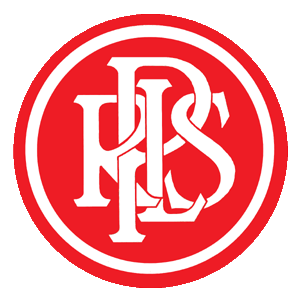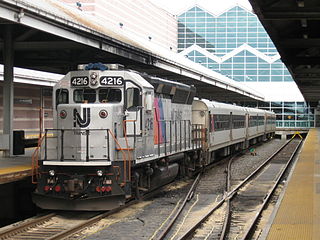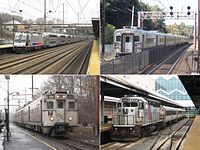
The Southeastern Pennsylvania Transportation Authority (SEPTA) is a regional public transportation authority that operates bus, rapid transit, commuter rail, light rail, and electric trolleybus services for nearly four million people in five counties in and around Philadelphia, Pennsylvania. It also manages projects that maintain, replace and expand its infrastructure, facilities and vehicles.

New Jersey Transit Corporation, branded as NJ Transit or NJTransit and often shortened to NJT, is a state-owned public transportation system that serves the U.S. state of New Jersey and portions of the state of New York and Pennsylvania. It operates bus, light rail, and commuter rail services throughout the state, connecting to major commercial and employment centers both within the state and in its two adjacent major cities, New York City and Philadelphia. In 2022, the system had a ridership of 175,960,600.

The PATCO Speedline, signed in Philadelphia as the Lindenwold Line and also known colloquially as the PATCO High Speed Line, is a rapid transit route operated by the Port Authority Transit Corporation (PATCO), which runs between Philadelphia, and Camden County, New Jersey.

The Delaware River Port Authority (DRPA), officially the Delaware River Port Authority of Pennsylvania and New Jersey, is a bi-state agency instrumentality created by a congressionally approved interstate compact between the state governments of Pennsylvania and New Jersey. The authority is principally charged to maintain and develop transportation links between the two states with four bridges and a mass transit rail line across the Delaware River. Though the DRPA has "port" in its name, it does not own or operate any ports.

The River Line is a hybrid rail line in southern New Jersey that connects the cities of Camden and Trenton, New Jersey's capital. It is so named because its route between the two cities is parallel to the Delaware River.

The Northeast Corridor Line is a commuter rail service operated by NJ Transit between the Trenton Transit Center and New York Penn Station on Amtrak's Northeast Corridor in the United States. The service is the successor to Pennsylvania Railroad commuter trains between Trenton and New York, and is NJ Transit's busiest commuter rail service. After arrival at New York Penn Station, some trains load passengers and return to New Jersey, while others continue east to Sunnyside Yard for storage. Most servicing is done at the Morrisville Yard, at the west end of the line.

Newark Penn Station is an intermodal passenger station in Newark, New Jersey. One of the New York metropolitan area's major transportation hubs, Newark Penn Station is served by multiple rail and bus carriers, making it the seventh busiest rail station in the United States, and the fourth busiest in the New York City metropolitan area.

NJ Transit Rail Operations is the rail division of NJ Transit. It operates commuter rail service in New Jersey, with most service centered on transportation to and from New York City, Hoboken, and Newark. NJ Transit also operates rail service in Orange and Rockland counties in New York under contract to Metro-North Railroad. The commuter rail lines saw 45,838,200 riders in 2022, making it the third-busiest commuter railroad in North America and the longest commuter rail system in North America by route length.

The Pennsylvania-Reading Seashore Lines was a railroad that operated in South Jersey in the 20th century. It was created in 1933 as a joint consolidation venture between two competing railroads in the region: the Pennsylvania Railroad and the Reading Company.

Transportation in Philadelphia involves the various modes of transport within the city and its required infrastructure. In addition to facilitating intracity travel, Philadelphia's transportation system connects Philadelphia to towns of its metropolitan area and surrounding areas within the Northeast megalopolis.

Lindenwold station is a train station in Lindenwold, New Jersey, United States, served by the NJ Transit Atlantic City Line regional rail service and the rapid transit PATCO Speedline. Lindenwold is the eastern terminus of PATCO; the system's headquarters and maintenance facility are located adjacent to the station in neighboring Voorhees.

The Atlantic City Rail Terminal is Atlantic City, New Jersey's train station, located inside of the Atlantic City Convention Center. It has five tracks served by three platforms and functions as the easternmost terminus of the NJ Transit Atlantic City Line to and from Philadelphia. The station was also served by the Atlantic City Express Service (ACES) from 2009 until it was formally discontinued on March 9, 2012.

Trenton Transit Center is the main passenger train station in Trenton, New Jersey. It is the southernmost stop in New Jersey on the Northeast Corridor. It is the terminus for NJ Transit trains to and from New York City and SEPTA Trenton Line Regional Rail trains to and from Philadelphia, Pennsylvania, and an intermediate station for Amtrak trains traveling between the two cities along the Northeast Corridor.

The Delair Bridge is a railroad bridge with a vertical-lift section that crosses the Delaware River between Philadelphia, Pennsylvania, and Pennsauken Township, New Jersey, just south of the Betsy Ross Bridge. The two-track bridge is part of Conrail Shared Assets Operations and is jointly used by Norfolk Southern Railway and CSX Transportation freight trains, as well as by the New Jersey Transit Atlantic City Line service.

The Walter Rand Transportation Center is a transportation hub located at Martin Luther King Boulevard and Broadway in Camden, New Jersey. It is served by the River Line, New Jersey Transit buses and Greyhound intercity buses and also includes the Broadway station of the PATCO Speedline.

Cherry Hill station is a NJ Transit train station in Cherry Hill, New Jersey, United States, on the Atlantic City Line. Eastbound service is offered to Atlantic City and Westbound service is offered to Philadelphia. The station runs through the former Garden State Racetrack property, currently occupied by two separate shopping centers. The station is accessible directly from Route 70. There is also an NJT 450 bus connection at the station, and the 406 bus on Route 70.

Absecon is a NJ Transit station in Absecon, New Jersey on the Atlantic City Line. It is located at South Station and Ohio Avenues.
The West Trenton Line is a proposed NJ Transit (NJT) commuter rail service that would be operated mostly on the CSX Transportation Trenton Subdivision, connecting West Trenton Station in Ewing Township, New Jersey with Newark Penn Station in Newark, New Jersey. The route would connect with the Raritan Valley Line at Bridgewater and the SEPTA West Trenton Line at West Trenton. As of 2007, NJT's estimate of the cost of creating a passenger line to West Trenton was $219 million. The project is still on the books, but no funding for the proposal has been secured to this date.

Egg Harbor City is a train station in Egg Harbor City, New Jersey. It serves NJ Transit trains and buses, as well as the Amtrak Thruway. Shuttles to the Egg Harbor City station connect to the Atlantic City International Airport, the Visitors Center at the FAA Technical Center and Stockton University, as well as bus lines to Atlantic City and the PATCO Speedline at the Lindenwold station.

Transportation in New Jersey utilizes a combination of road, rail, air, and water modes. New Jersey is situated between Philadelphia and New York City, two major metropolitan centers of the Boston-Washington megalopolis, making it a regional corridor for transportation. As a result, New Jersey's freeways carry high volumes of interstate traffic and products. The main thoroughfare for long distance travel is the New Jersey Turnpike, the nation's fifth-busiest toll road. The Garden State Parkway connects the state's densely populated north to its southern shore region. New Jersey has the 4th smallest area of U.S. states, but its population density of 1,196 persons per sq. mi causes congestion to be a major issue for motorists.


























